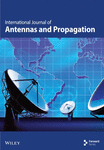Wideband Compact Planar Antenna With Curved Transmission Lines and ACPW Structure
Abstract
In this paper, the proposed wideband compact planar antenna is realized by incorporating multiple curved transmission lines along with the interdigital capacitor (IDC) and the electric inductor–capacitor (ELC) resonator. Furthermore, this antenna implements an asymmetric coplanar waveguide (ACPW) via-less structure. A prototype of the proposed antenna has been fabricated with a compact size of 0.33λ0 × 0.26λ0 at the lower operating frequency of 2.3 GHz. The obtained measured results indicate a wide bandwidth that can cover the frequency band from 2.3 GHz to 4.11 GHz, corresponding to a −10 dB fractional bandwidth of 56.47%.
1. Introduction
There has been significant interest in wideband and compact planar antennas. Planar antennas, in various configurations, offer attractive features such as being low-profile, lightweight, and having a wide bandwidth. Nevertheless, designing these antennas becomes more challenging as the need arises to decrease their size while expanding the operating frequency band. Consequently, numerous efforts have been made to enhance the bandwidth and miniaturize planar antennas. For instance, a triple-band slotted bow-tie antenna with curved monopoles was discussed in [1]. The authors of [2] presented an antenna capable of covering GSM and Wi-Fi/WLAN frequencies using a rectangular patch and a high-impedance microstrip line. Additionally, a compact and broadband antenna featuring a Y-shaped central monopole was investigated in [3]. In [4], a CPW-fed monopole antenna with a parasitic circular-hat patch and slotted CPW ground was developed to excite dual resonant modes and enhance the overall impedance bandwidth. Moreover, a compact bow-tie quasi-self-complementary antenna suitable for ultrawideband (UWB) applications was proposed in [5]. The authors of [6] introduced a dual-band magnetoelectric dipole antenna with complementary capacitively loaded loop slots, while the authors of [7] presented a compact coplanar-fed planar multiband antenna. In [8], two composite right-/left-handed transmission line (CRLH-TL) unit cells are integrated with a monopole. These two CRLH-TL structures create two separate zeroth-order resonances (ZORs). By adjusting the length of the meander line in each CRLH-TL unit cell, these two resonant modes can be combined to expand the lower bandwidth from 820 to 960 MHz. Additionally, the quarter-wavelength monopole generates a resonant mode in the DCS1800/PCS1900/UMTS band.
The development of antennas for wireless energy harvesting represents a critical research area. An essential design parameter, in addition to achieving wide bandwidth and compact size, is the antenna’s ability to detect both copolarization and cross-polarization components of the incident wave, thereby enhancing energy reception. In [9, 10], the antenna exhibits both copolarization and cross-polarization radiated fields, indicating its capability to receive RF waves with vertical or horizontal polarization. This performance validates the antenna’s effectiveness for use in wireless energy harvesting applications. In [11], the average received power was measured in urban areas, ant it was found that the combined reception of cross-polarized waves significantly enhances the received power.
This paper introduces an antenna design that incorporates curved segments of transmission lines, an IDC, and an ELC resonator. The proposed antenna features a via-less, single-layer geometry with enhanced bandwidth, achieved through the utilization of an asymmetric coplanar waveguide (ACPW) structure. The use of the IDC helps to increase the overall capacitance of the proposed antenna. Furthermore, curved transmission line sections have been implemented to achieve higher inductance values in a smaller area. The incorporation of the IDC, ELC, and curved segments of transmission lines provides the flexibility to manipulate both the total inductance and capacitance of the proposed antenna. This manipulation allows for an increase in the overall capacitance and inductance within the structure, leading to a downward shift in the resonance frequency and consequently reducing the physical dimensions of the antenna relative to its operating wavelength. The design choice for the curved segments of the transmission lines also enables the reception of both copolarization and cross-polarization components of the incident wave. Furthermore, the ELC resonator enhances the antenna’s ability to achieve high absorptivity. The proposed antenna was designed as a promising choice for wireless energy harvesting applications.
2. Development of the Proposed Antenna
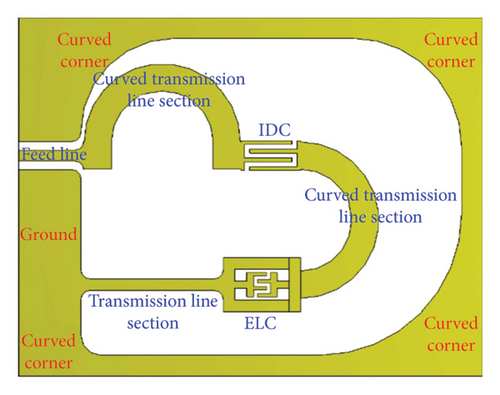
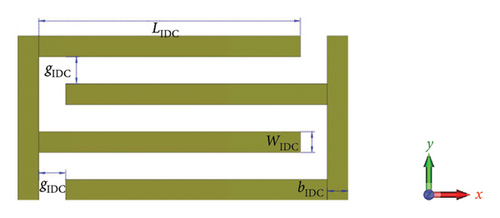
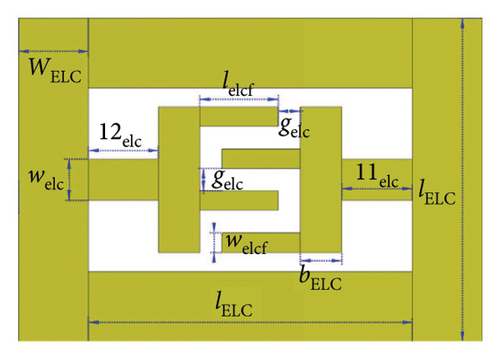

The inductance value for the ELC central branch (LCN) can be determined by using (7), where the total length of the central conductor is represented by (l1elc + l2elc) and its width is denoted by welc. The total inductance of the ELC resonator is obtained as LELCt = (LELC/2)‖LCN. Moreover, Figure 1(c) depicts the dimensions of the microstrip structure of the interdigital capacitor within the ELC resonator, which can be substituted into (1), to determine the lumped value of the IDC capacitance (CELC) in the ELC resonator. Furthermore, the inductance values (L1) and (L2) of each curved transmission line section can be determined by replacing the width and length parameters in (7) with the corresponding dimensions of each curved transmission line section, as depicted in Figure 1(d). In addition, the transmission line segment that connects the ELC resonator to the ground has an inductance denoted as (L3). The determination of this inductance value is achieved through (7) by replacing the conductor’s length and width with (Ld) and (Wk), respectively. The lowest resonance frequency of the proposed antenna depends on the dimensions of the transmission line sections, as well as the configurations of the IDC and the ELC resonator. This resonance frequency can be calculated as , where Ltot and Ctot represent the total inductance and capacitance of the proposed antenna, as indicated in Figure 2.
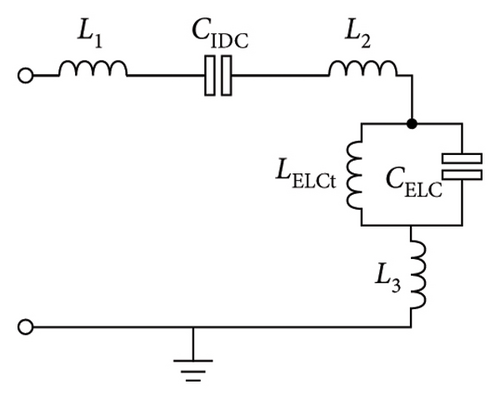
3. Results and Discussions
The proposed antenna was simulated and fabricated on the FR4 substrate with a thickness of 1 mm and a dielectric constant of 4.4. The design process began by developing a CST model. Subsequently, the tuning and optimization tools available in CST Studio Suite were utilized to enhance the CST simulation results. The optimized dimensions for the proposed antenna are illustrated in Figures 1(b), 1(c), and 1(d). The via-free single-layer antenna was constructed by implementing the ACPW structure.
A prototype of the antenna was fabricated, as shown in Figure 3. The reflection coefficients, both simulated and measured, are plotted in Figure 4. The Rohde & Schwarz ZNB 40 vector network analyzer was used to measure the S-parameters. The measured −10 dB bandwidth ranges from 2.3 GHz to 4.11 GHz, with a fractional bandwidth (FBW) of 56.47%.
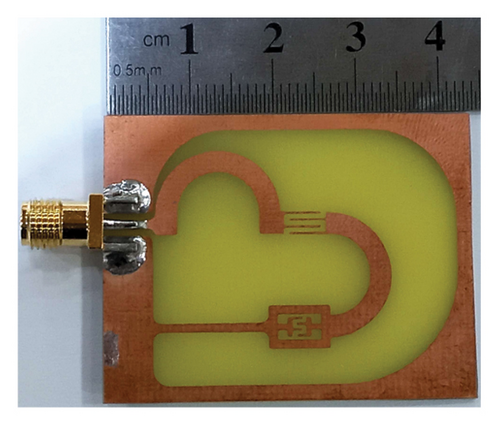
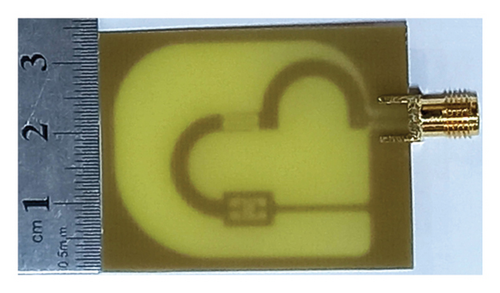
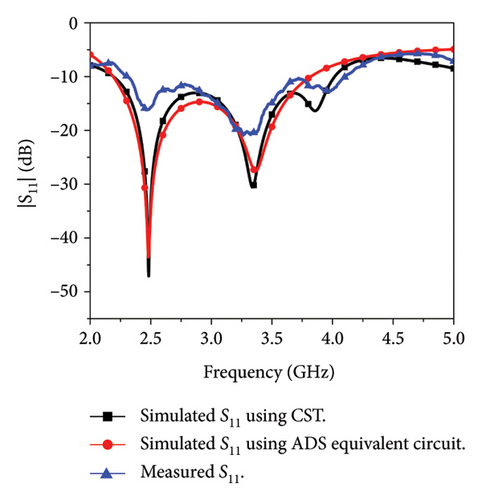
The equivalent circuit model of the proposed antenna was developed by first calculating the inductances L1, L2, LELCt, and L3 using (7)–(8), which initially resulted in values of 3.16, 2.68, 0.35, and 2.7 nH, respectively. Similarly, the capacitances CIDC and CELC were initially determined based on (1)–(6), with initial values of 0.36 and 0.11 pF. The coupling between the feed line and ground was accounted for by incorporating the coupling capacitance C1, while the coupling capacitances between the curved transmission line sections and the ground were modeled by adding C2 and C3 to the equivalent circuit. Moreover, the radiation resistances associated with the transmission line segments and the ELC resonator were represented as R2 and R3, respectively. Finally, the free-space characteristic impedance R1 was connected in parallel with the proposed antenna’s equivalent circuit. The complete equivalent circuit model was simulated using ADS software, as illustrated in Figure 5. The component values in the circuit model were optimized and fine-tuned to achieve an S-parameter closely matching that obtained from CST simulations, as shown in Figure 4.

A parameter analysis was conducted to examine the impact of variations in structural dimensions on the performance of the proposed antenna. Specifically, the effects of modifying the dimensions of the curved transmission lines and the number of IDC fingers on the resonance frequencies were analyzed while maintaining the overall size of the proposed antenna at 0.33λ0 × 0.26λ0. Figure 6(a) shows that increasing the diameter of the curved transmission line from 7.7 mm to 9.7 mm shifts the lowest resonant frequency downward from 2.61 GHz to 2.47 GHz. Additionally, as shown in Figure 6(b), increasing the number of IDC fingers from 4 to 8 results in a resonant frequency shift from 3.37 GHz to 3.27 GHz.
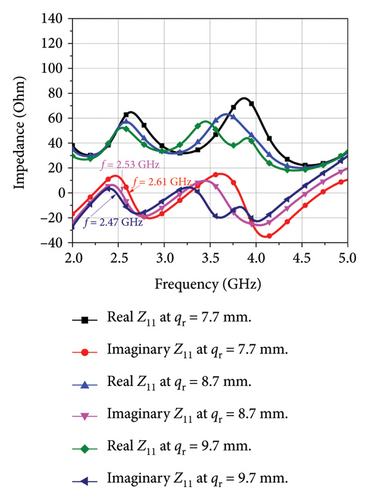
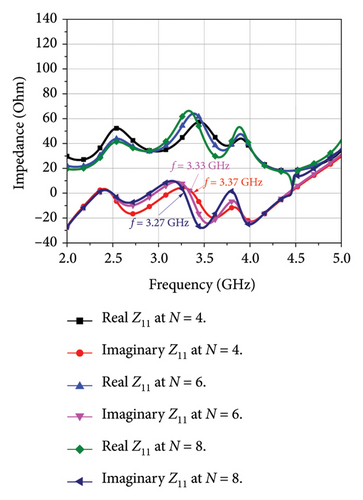
The simulated and measured far-field realized gain at frequencies of 2.5 GHz and 3 GHz is depicted in Figure 7. These patterns exhibit a nearly omnidirectional characteristic across all frequencies of interest. Additionally, the far-field realized gain observed in the xz and yz planes is almost identical. Figures 7(a) and 7(d) further illustrate that both copolarization and cross-polarization components can be received. Figures 7(e), 7(f), 7(g), and 7(h) show the total radiation patterns of XY and YZ planes at 2.5 and 3 GHz, respectively.
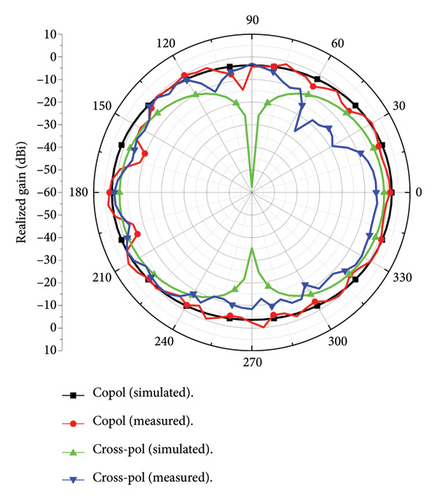
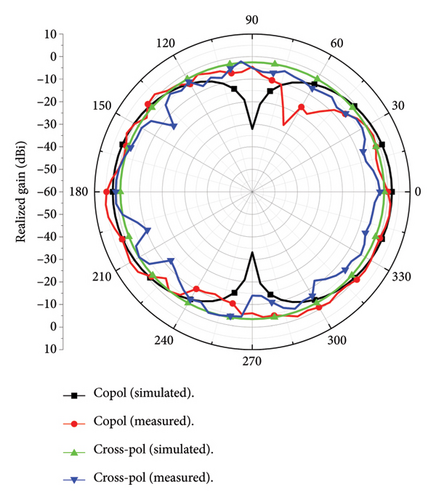
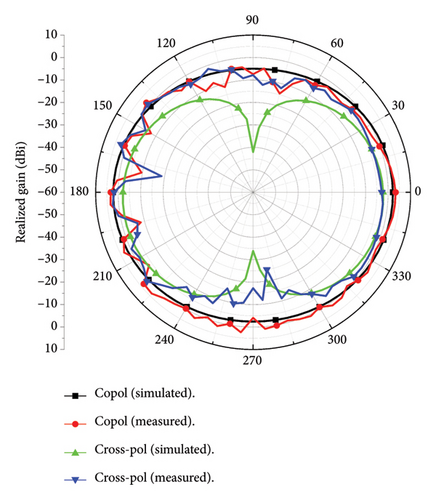

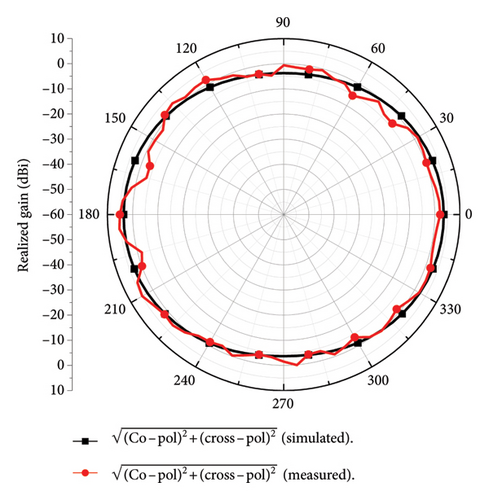

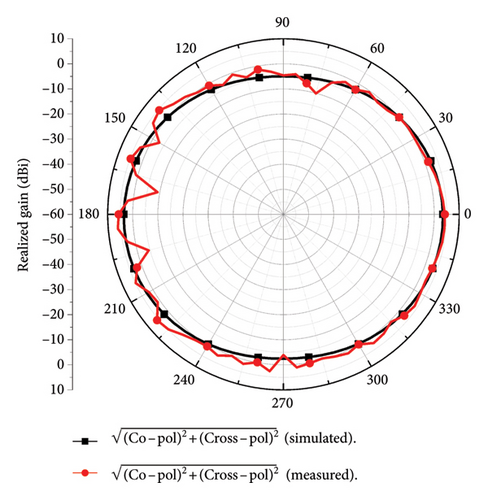
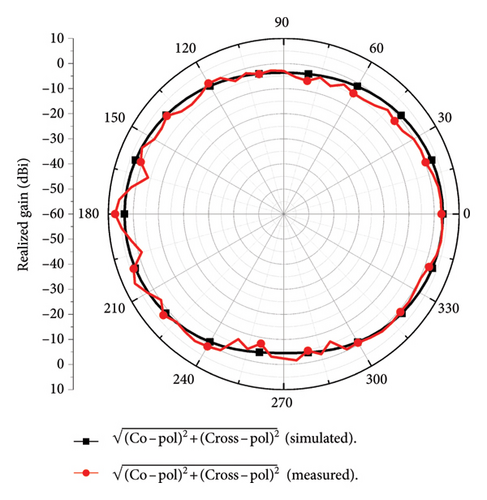
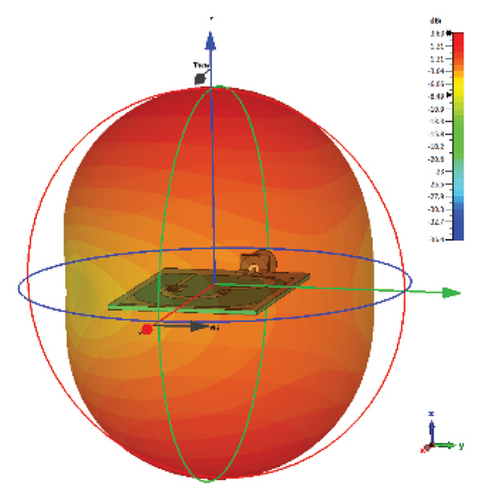
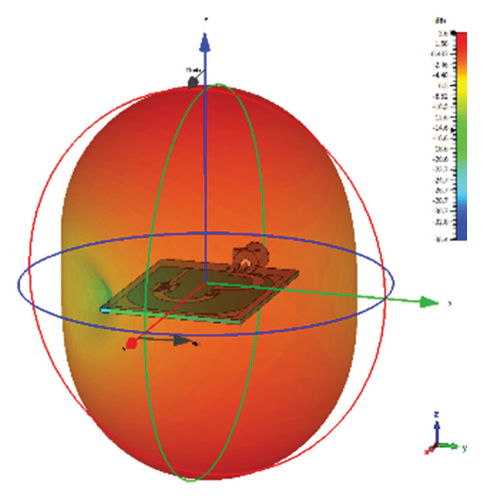
The radiation characteristics of the proposed antenna were measured at the Korea Institute of Electronic Technology. In the frequency band of 2–5 GHz, the maximum measured total efficiency (η) is 89.96%, while the measured antenna’s peak realized gain is 7.68 dBi as shown in Figure 8.
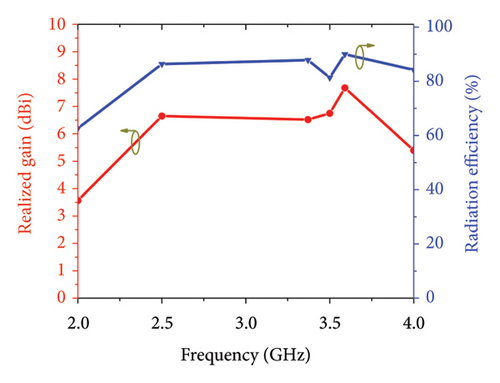
Figures 9(a) and 9(b) illustrate that the electric field distribution is more intense near the transmission line sections, IDC, and the ELC resonator, which causes the operating frequency of the proposed antenna to be determined by the geometry of these components. Moreover, the geometry of the curved sections allows the proposed antenna to support diverse polarizations. As illustrated in Figures 9(c) and 9(d), the electric and magnetic field lines are perpendicular to one another, resulting in omnidirectional radiation, as indicated in Figures 7(i) and 7(j).
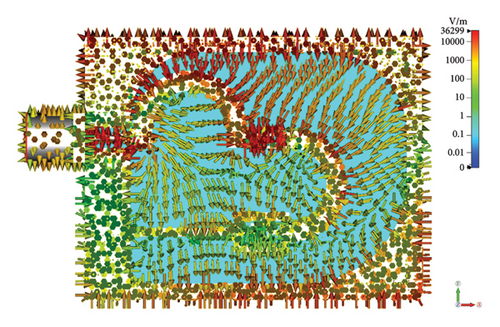
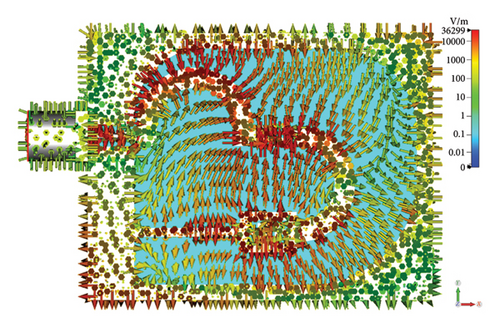
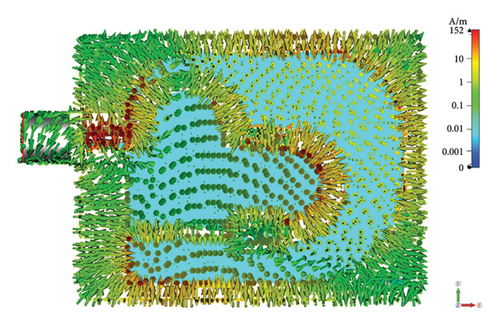
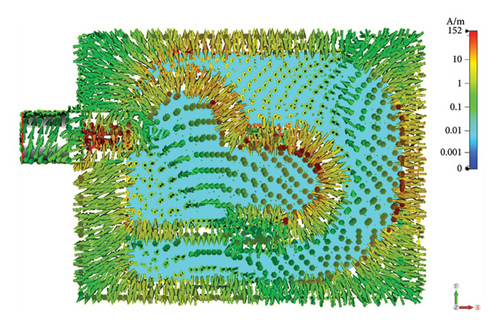
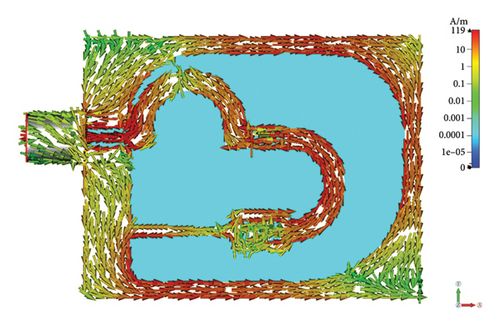
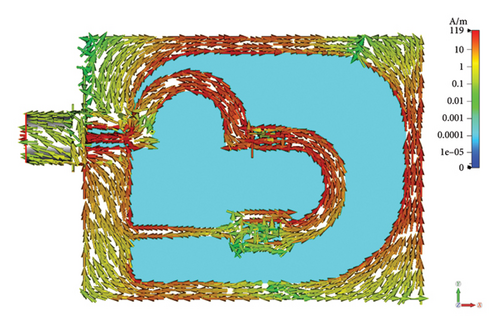
The surface current distribution on the curved sections of the transmission line, IDC, and the ELC resonator induces an additional surface current distribution on the ground plane of the proposed ACPW antenna, as illustrated in Figures 9(e) and 9(f). This phenomenon increases the effective radiating area, enhances radiation efficiency, and contributes to improved bandwidth and gain performance.
Table 1 compares the proposed antenna with previously published relevant studies. The proposed antenna exhibits a significantly wide bandwidth, a relatively compact size of 0.33λ0 × 0.26λ0, and a via-free, single-layer simple structure that can achieve high performance without the need for varactors or pin diodes. Although some designs, such as [15], feature a smaller footprint, they achieve this at the cost of reduced bandwidth and lower gain. Additionally, certain compact designs introduce structural complexities, such as the use of vias in [14, 18, 19], or varactors in [16, 17]. The designs in [20, 21] also provide wideband operation with FBWs of 51.6% and 61%, respectively. However, their peak gains (3.7 dBi and 3.8 dBi) are significantly lower than that of the proposed antenna.
| Ref. | Dimensions (λ0 × λ0) | No. of metal layers | No. of vias | No. of diodes | BW (GHz) | FBW (%) | Max. Eff. (%) | Peak gain (dBi) |
|---|---|---|---|---|---|---|---|---|
| [9] | 0.42 × 0.42 | 2 | No | No | 1.8–2.5 | 32.56 | NA | 4.1 |
| [10] | 0.35 × 0.32 | 1 | No | No | 0.85–1.94 | 78.14 | 75 | 2 |
| [14] | 0.21 × 0.08 | 2 | 2 | No | 2.41–2.43 | 1 | 53 | −0.53 |
| [15] | 0.12 × 0.13 | 1 | No | No | 1.56–1.64 | 5 | 88 | 2.9 |
| 3.43–3.65 | 6.21 | |||||||
| 4.2–7.59 | 57.2 | |||||||
| [16] | 0.18 × 0.16 | 2 | No | 3 varactors | 1.58–2.12 | 29.1 | < 40 | 4 |
| 2.24–2.68 | 17.8 | |||||||
| 3.08–3.78 | 20.4 | |||||||
| [17] | 0.11 × 0.1 | 2 | No | 1 varactor | 0.75–0.96 | 24.5 | 78 | 2.1 |
| 1.25–1.94 | 43.2 | |||||||
| [18] | 0.19 × 0.09 | 2 | 3 | No | 2.85–2.9 | 1.7 | 46 | −0.82 |
| [19] | 0.2 × 0.14 | 2 | 2 | No | 2.25–2.35 | 4.4 | 79 | 2.3 |
| [20] | 0.39 × 0.33 | 1 | No | No | 2.3–3.9 | 51.6 | NA | 3.7 |
| [21] | 0.24 × 0.49 | 1 | No | No | 2.8–5.25 | 61 | NA | 3.8 |
| This work | 0.33 × 0.26 | 1 | No | No | 2.3–4.11 | 56.47 | 89.96 | 7.68 |
The proposed antenna can be a promising choice for wireless energy harvesting applications within the 2.3–4.11 GHz range, particularly for IoT devices and low-power sensors. This frequency range overlaps with ambient RF sources such as Wi-Fi (2.4 GHz) and LTE bands, enabling efficient energy capture.
4. Conclusion
This paper introduces a novel antenna design utilizing an ACPW structure with curved transmission line segments, an IDC, and an ELC resonator. Incorporating the IDC, ELC, and curved transmission line sections results in a lower resonance frequency and a reduction in physical dimensions relative to the antenna’s operating wavelength. The proposed antenna, with an ACPW structure, exhibits a wide bandwidth and a compact physical size of 0.33λ0 × 0.26λ0. Experimental measurements demonstrate that the antenna achieves an impedance bandwidth of −10 dB, spanning 1.81 GHz (2.3–4.11 GHz). Furthermore, the proposed antenna design features a simple structure without vias, a nearly omnidirectional radiation pattern, and the ability to receive both copolarization and cross-polarization waves. Therefore, the proposed antenna can be a promising choice for wireless energy harvesting applications.
Conflicts of Interest
The authors declare no conflicts of interest.
Funding
This work was supported in part by the Korean Government (MSIT) through the National Research Foundation of Korea, South Korea, under Grant RS-2024-00338277 and in part by the Institute of Information & Communications Technology Planning & Evaluation (IITP) grant funded by the Korea government (MSIT), under Grant RS-2022-00156409 (ICT innovation human resources 4.0).
Open Research
Data Availability Statement
Data sharing is not applicable to this article as no datasets were generated or analyzed during the current study.



